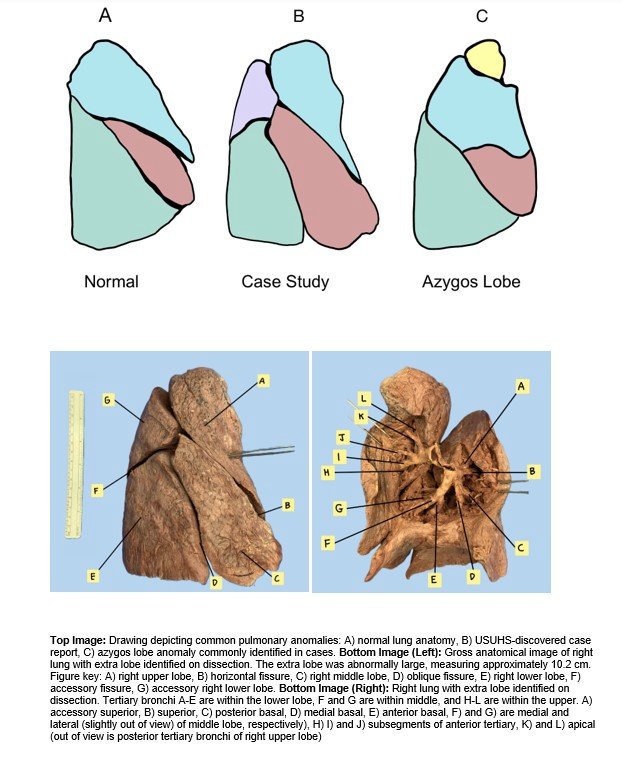Thorax Case & Anatomical Studies Posters
Poster: Thorax Case & Anatomical Studies Posters
48 - Pulmonary Lobe Variations and Clinical Implications: A Case Series
Saturday, March 23, 2024
5:00pm - 7:00pm US EDT
Location: Sheraton Hall
Poster Board Number: 48
There are separate poster presentation times for odd and even posters.
Odd poster #s – first hour
Even poster #s – second hour
Co-authors:
There are separate poster presentation times for odd and even posters.
Odd poster #s – first hour
Even poster #s – second hour
Co-authors:
Aaron Dowdell - Medical Student, School of Medicine, Uniformed Services University of Health Sciences; Juliana Pitzer - Medical Student, School of Medicine, Uniformed Services University of Health Sciences; Tracy Lord - Medical Student, School of Medicine, Uniformed Services University of Health Sciences; Michael Morell - Medical Student, School of Medicine, Uniformed Services University of Health Sciences; Guinevere Granite, M.S., M.A., Ph.D - Director of Human Anatomy, Department of Surgery, Uniformed Services University of Health Sciences; Maria Leighton, M.D. - Assistant Professor, Department of Surgery, Uniformed Services University of Health Sciences; Jinbum Dupont, M.S. - Medical Student, School of Medicine, Uniformed Services University of Health Sciences; Elizabeth Maynes, M.D. - Assistant Professor, Department of Surgery, Uniformed Services University of Health Sciences
- LW
Lauren Whitlock
Pre-Med Student
Georgetown University
Village A H103, District of Columbia, United States
Presenting Author(s)
Abstract Body : Intro - In normal human anatomy, the right and left lungs consist of three and two lobes, respectively. During embryological development, variations including accessory or missing fissures may lead to pulmonary lobe abnormalities. The clinical relevancy of this is not fully understood.
Aims - This research will investigate the prevalence and potential clinical outcomes of such anatomical variations as well as present a related case discovered.
Methods - During a routine dissection at USUHS, an anomalous anatomical variation was discovered in the form of an additional right lung lobe. The finding warranted further examination of the literature to potentially enhance our understanding of pulmonary anatomy. An electronic search was performed to identify all relevant studies that discussed pulmonary lobe variations.

Results - After assessment for inclusion and exclusion criteria, 14 cases were pooled for preliminary analysis from 570 identified studies. We found that one of the most common anomalies is the presence of an azygos lobe. Out of the included cases, 78.6% (1114) presented with an azygos lobe and 21.4% (314) presented with non-azygos variations, including accessory fissures and lobes.
All included variations were discovered incidentally following investigative procedures involved with other pathologies, including pulmonary disease, lung cancer, metastatic cancer arising from a non-pulmonary site, COPD, myocarditis, and general dyspnea. It remains uncertain whether these conditions were related to their pulmonary anomaly. Baseline characteristics of the patients were recorded. From these findings, we are going to delve into the literature by performing a systematic review and meta-analysis in the coming year.
Conclusion - Lung lobe variations should be identified in patients before any pulmonary procedure including lobectomy, lymph node dissection, and lung transplantation, owing to the potential effects on clinical outcomes in these patients.
Aims - This research will investigate the prevalence and potential clinical outcomes of such anatomical variations as well as present a related case discovered.
Methods - During a routine dissection at USUHS, an anomalous anatomical variation was discovered in the form of an additional right lung lobe. The finding warranted further examination of the literature to potentially enhance our understanding of pulmonary anatomy. An electronic search was performed to identify all relevant studies that discussed pulmonary lobe variations.
Results - After assessment for inclusion and exclusion criteria, 14 cases were pooled for preliminary analysis from 570 identified studies. We found that one of the most common anomalies is the presence of an azygos lobe. Out of the included cases, 78.6% (1114) presented with an azygos lobe and 21.4% (314) presented with non-azygos variations, including accessory fissures and lobes.
All included variations were discovered incidentally following investigative procedures involved with other pathologies, including pulmonary disease, lung cancer, metastatic cancer arising from a non-pulmonary site, COPD, myocarditis, and general dyspnea. It remains uncertain whether these conditions were related to their pulmonary anomaly. Baseline characteristics of the patients were recorded. From these findings, we are going to delve into the literature by performing a systematic review and meta-analysis in the coming year.
Conclusion - Lung lobe variations should be identified in patients before any pulmonary procedure including lobectomy, lymph node dissection, and lung transplantation, owing to the potential effects on clinical outcomes in these patients.

